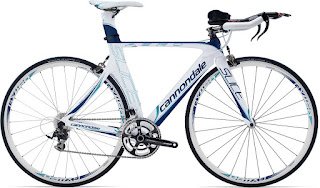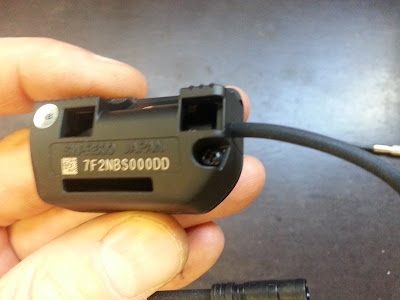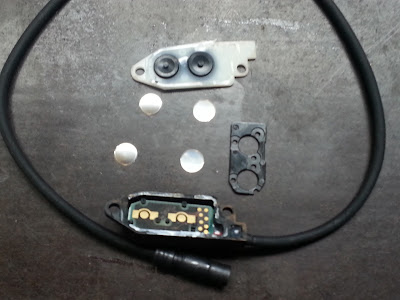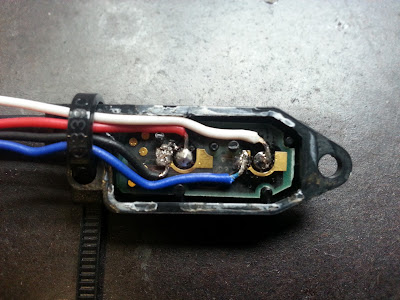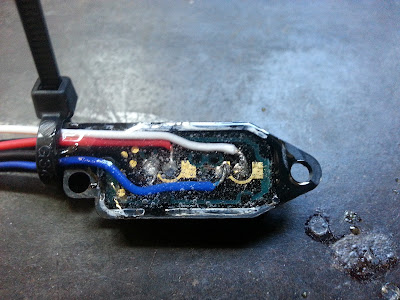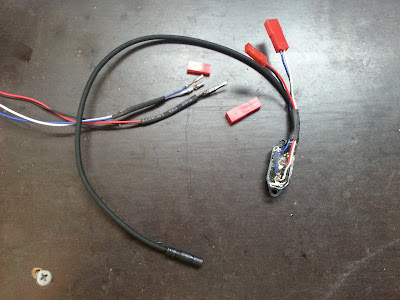|
SPEC
|
BEFORE UPGRADE
|
AFTER UPGRADE
|
|
FRAME
|
SLICE WOMEN'S, FULL CARBON,
650C
|
SLICE WOMEN'S, FULL CARBON,
650C
|
|
FORK
|
SLICE AERO, FULL CARBON,
1-1/8"
|
SLICE AERO, FULL CARBON,
1-1/8"
|
|
SEAT POST
|
SLICE CARBON AERO, 2 POSITION,
350mm
|
SLICE CARBON AERO, 2 POSITION,
350mm
|
|
CRANK
|
FSA GOSSAMER PRO BB30, 53/39
|
FSA GOSSAMER PRO, BB30, 165mm
LENGTH
|
|
BOTTOM BRACKET
|
FSA BB30
|
FSA BB30
|
|
CRANK GEARING
|
53/39 (650C VERSION)
|
53/39 (650C VERSION)
|
|
COG SET
|
SHIMANO 105 5700, 11-28,
10-SPEED
|
SHIMANO ULTEGRA, 6700,
12-25, 10 SPD
|
|
CHAIN
|
SHIMANO 105 5700, 10-SPEED
|
SHIMANO DURA ACE, 7900, 10
SPD
|
|
FRONT DERAILLEUR
|
SHIMANO 105, 5700, BRAZE-ON
|
SHIMANO ULTEGRA, FD-6770,
Di2
|
|
REAR DERAILLEUR
|
SHIMANO 105 5700
|
SHIMANO ULTEGRA, RD-6770,
Di2
|
|
BAR END SHIFT
|
MICROSHIFT BS-A10
|
SHIMANO ULTEGRA, SW-R671,
Di2
|
|
BASE BAR SHIFT
|
N/A
|
SHIMANO ULTEGRA, SW-R600,
Di2
DIY BUTTONS |
|
FRONT BRAKES
|
TEKTRO R520 (Silver)
|
TEKTRO 920 AERO
U BRAKE ADAPTER (Black) |
|
REAR BRAKES
|
TEKTRO R520 (Silver)
|
TEKTRO 520 (Black)
|
|
BRAKE LEVERS
|
PROMAX AERO LEVERS
|
PROMAX AERO LEVERS
|
|
RIMS (650C)
|
MADDUX AERO G40(650C)
|
RACE: ZIPP 404, TUBULAR,
TOROIDAL
TRAIN: MADDUX AERO G40 |
|
HUBS
|
FORMULA RB51, RB52
|
RACE: ZIPP 84/204, 10 SPEED
TRAIN: FORMULA RB51, RB52 |
|
SPOKES
|
DT SWISS CHAMPION 24F/28R
|
RACE: SAPIM CX RAY 16F/20R
TRAIN: DT SWISS CHAMPION 24F/28R |
|
PEDALS
|
N/A
|
GARMIN VECTOR S / LOOK KEO
|
|
HANDLEBAR
|
CANNONDALE C3 BASE BAR, 31.8
|
3T BREZZA, CARBON
INTERNAL CABLE ROUTING |
|
AEROBAR
|
PROFILE T2 ALLOY CLIP ON
|
3T BREZZA, CARBON
INTERNAL CABLE ROUTING |
|
STEM
|
CANNONDALE C3
6 DEGREE, 31.8, 70mm L |
3T ARX II
17 DEGREE, 80mm L |
|
HEADSET
|
CANE CREEK, 20mm TOP CAP
|
CANE CREEK
TEKTRO 1275AP.1 CABLE HANGER CAP |
|
GRIPS
|
CANNONDALE SUEDE GRIP TAPE
|
SRAM SUEDE GRIP TAPE
|
|
SADDLE
|
PROLOGO CAPPA DEA
|
ISM ADAMO PROLOGUE
|
Cannondale Slice Upgrade
It's the off season: the perfect time for bike upgrades!
This year Nat has signed up for her first 70.3 triathlon so her TT bike will become the weapon of choice for training and racing with a long course focus. She is currently getting around on this Cannondale Slice Women's specific.
It is the XS size with the 650c wheels which suits as Nat stands 156cm (5'2")
It was bought second hand and has served her well for a couple of seasons but it has fairly entry level specs:
- 105 mechanical shift
- Semi internal cabling
- Basic aluminium cockpit
- Conventional stem
- Standard Tekro brakes
- Ok 30mm deep aero wheels
So starts the project we will Blog about over the next month or so.
Monday 17 August 2015
UPGRADE SPEC SHEET
Saturday 1 August 2015
CANNONDALE SLICE Di2 UPGRADE COMPLETE
Finally the Cannondale Slice 650C TT bike is reassembled with all the upgrades in place.
Since the last post I have refitted all the little finishing touches:
- Carbon handlebars
- Brake cables and new bar tape
- Bar mount hydration
- Xlab nutrition storage
- Rear mount bottle cage
- New Zipp Decals
We are super happy with the end result.
Nat took it out to the local criterium track for a test run and her first ever power test!
She was able to maintain her more aggressive aero position comfortably for a full 30 minute time trial with the arm pads 38mm lower than previous!
I will post more about the bike fit in one of my next posts.
I will post more about the bike fit in one of my next posts.
Sunday 26 July 2015
HANDLEBAR AND DIY Di2 REMOTE SHIFT - PART 2
After a few delivery hassles I finally received the Cateye #169-9200 buttons I needed to upgrade the handlebars and finish the project. The buttons are impossible to get in Australia so I had them shipped from the U.S.
I have already progressed the DIY shift somewhat and this is discussed in a previous post.
My plan is as follows:
I have already progressed the DIY shift somewhat and this is discussed in a previous post.
My plan is as follows:
- Start with the new carbon handlebars
- Install the Cateye #169-9200 buttons for shifting the rear derailleur
- Install the R600 circuit board inside the stem
- Internally wire between the buttons to the R600 circuit board
- Wire from the R600 circuit board to the 5 port module on the stem
- Reassemble with new brake cables
First I prepare the handlebars. They are not designed what I have in mind so I need to drill a few holes. I keep these holes around 3mm as I only intend to pull the very small 24AWG cables through them. I don't need to feed any of the 5mm E-tube plugs through the bars.
Cables are fed from small holes in the back of the stem clamp area out to each bar end. As with the main frame this was very tricky and I used old inner brakes cables as feeder wires.
A small hole is drilled on the inner side of each bar end 40mm from the end of the tube. It needs to back from the end to clear the brake levers which insert in the tubes later.I fish the wires through and out of this hole.
At this stage I use a multimeter (or test light) to make sure the wires are still continuous and have not been damaged while I was pulling them through.
Next I add the buttons at each bar end. There are a couple of ways to go about this:
- I could cut the Cateye cables and splice my wires onto them (Non-preferred)
- Connect my wires directly to the buttons (Preferred)
The picture below shows the buttons opened up which is very easy to do. There was a small amount of sealant holding it together which I replaced with some 5 minute epoxy. I de-solder the existing wires, pass my, more robust, wires through the button cover and solder them on to the same terminals:
I was on a roll and forgot to take pictures along the way but here is the end results with a button installed on the underside of the handlebars.
The button holders have some small cable guides moulded into them that clamp the cables and offer some strain relief. Later the bar tape will wrap over and conceal these buttons.
Surprisingly when I did this on my Shiv upgrade a while back I found that even with thick winter gloves the buttons are every easy to use under the bar tape.
The other end of the cables at the stem get a set of the small red JST plugs to match those on the R600 module board and and I feed the brake cables through the designated holes under the bars and the whole assembly is now ready.
Next I move onto the stem and hiding the R600 rear derailleur control module.
I need to hide the R600 climbing module because it is just a control board removed from the shifter, is pretty ugly and no longer has a proper housing to mount it. I decide to hide it in the stem but this means I need to drill a hole in the stem to get the E-tube wire out and around to the 5 port module on top of the stem.
I am very careful about where I drill the stem as I don't want to weaken a high stress area. A handlebar stem is a cantilever so when the rider puts weight on the bars the steam he top of the stem has the highest tensile stresses and the fork clamp area see the highest bending loads due to the lever action.
Image below shows the underside of the stem with the 5.5mm hole drilled on the underside and toward the handlebar end but not too close to the threads which may have local stresses from the bolt tensioning
I route the E-tube wire from inside the stem up to the module on the top. The module strap helps secure the cable to the stem. The R600 module is wrapped with foam and zip ties which will stop it rattling inside the stem
The excess E-tube cable is wrapped around the module and it is all poked into the stem
Now the handlebars can be fitted and the internal wiring connected
From here it is just a matter of re-installing the aerobars, bar end shifters and the brake cables which I will write about soon.
Saturday 11 July 2015
Di2 AND BRAKE INSTALL - PART 2
I'm still waiting on the new cockpit and the front brake cable hanger so I decide to reassemble as so it can go back on the wind trainer for more trial bike fitting with the new stem and armpads flipped back to the top of the aerobars.
I cut the excess length off the base bar horns and now the only main difference is that the new base bar will be flat and sit 35mm higher than the drop bars on there now. Pad height will be similar.
Refit the old cockpit and shortened base bar
TRP T920 Front brake installed ready for cables
I cut the excess length off the base bar horns and now the only main difference is that the new base bar will be flat and sit 35mm higher than the drop bars on there now. Pad height will be similar.
Refit the old cockpit and shortened base bar
A-Junction installed on top of stem (stem was too short to mount underneath)
Re-fit old bar tape until and reuse the old rear brake cable until the new bars arrive
Back together on the ZIPP wheels (Stealth look until decals arrive)
Training wheels and XLAB pocket 100 Bento box which fits in perfectly behind the stem.
Tip - Bento box is a great spot for the TV remote while on the wind trainer!
Really happy with the results so far, no more lever style bar end shifters, just crisp reliable shifting at the push of a button and a much cleaner looking ride!
We are still waiting on, Carbon Cockpit, Front Brake Hanger, Cateye Buttons and Zipp decals which should arrive in the next week or so.
We will have a few finishing touches before it is fully race ready, such as installing some drink holders and fine tuning the bike fit.
Di2 DIY TIME TRIAL REMOTE SHIFTERS - PART 1
One of the great parts about electronic shifting is the ability to install multiple shifters. In this case we want shifters at TT bars and the brake levers on the base bar. While this is great, it is also quite costly with the Shimano Di2 Brake levers retailing at around $400 with no other alternatives on the market right now.
I unscrew and disassemble the shifter body
Remove the main circuit board and dispose of the rest
I have the remaining lengths of 20AWG cable with the terminals crimped and ready to go waiting for a set of Cateye #169-9200 remote buttons and the new base bar to arrive.
This do it yourself time trial remote shifter mod is nothing new, quite a few people have done this for bikes where replacing the brakes levers isn't possible, e.g hydraulic brake levers and my Shiv TT where I need the cable adjusters barrels in the brake lever.
This modification requires the following parts:
- SW-R600 Climbing shifter (Options are SW-R671 or ST-6770/6870 right shifter)
- 4 x 0.5m lengths of small electrical cable (I stripped a 4 core alarm cable 24AWG)
- 2 x 2 pin connectors (I used JST connectors used for RC cars)
- Cateye #169-9200 Remote Buttons
- 5 Minute Epoxy
- Heat Shrink
- Soldering Iron
Note these parts will provide control for the rear derailleur only. I will install one button at each brake lever. The left button for an easier gear, right button a harder gear.
If you want to install front derailleur shifting also, you will also need an STI or time trial left side shifter and some extra buttons.
Remove the main circuit board and dispose of the rest
I remove the cover and buttons from the circuit board
The circuit board is now ready for the remote button wiring
I Solder the 20AWG wires to the button contacts as shown below. I stagger the wires to ensure the centre wires don't cross the outer contacts or the other wires where they could short out.
Shifting occurs when White & blue or Red & Black are connected via a remote push button.
At this stage I plug the E-tube wire into the module on my bike and test the shifting by touching the wire pairs together momentarily. If it tests ok I seal up the unit with 5 minute epoxy.
I add some small JST connectors and heat shrink. I use the male connector on one pair, female on the other to prevent potential mix ups when I assemble it later.
I have the remaining lengths of 20AWG cable with the terminals crimped and ready to go waiting for a set of Cateye #169-9200 remote buttons and the new base bar to arrive.
Wednesday 8 July 2015
Di2 INSTALLATION PART 1 - INTERNAL CABLES AND BATTERY
The Di2 components have arrived so now the
fun begins! I will let the pictures do the talking now that the planning is out of the way and I’m
getting my hands dirty.
First I strip the bike down
to a bare frame and fork. I fit the new stem to stop the fork sliding out and to allow me to
locate the A-module later and finalise the front wire location.
| NEW PARTS HAVE ARRIVED |
PREPARE FRAME FOR
INTERNAL CABLING
I still need to do a bit more preparation for the internal cabling
As shown in a previous post I had already drilled a 7mm hole to provide cable access from the seat tube to the bottom bracket cavity.
To prepare for the rear derailleur cable I remove the mechanical cable stopper from the underside of the drive side rear stay.
| DRILL RIVETS OUT OF CABLE STOP |
| PRY CABLE STOP AWAY FROM FRAME |
I enlarge one of the holes to 5.5mm enough to feed the 5mm head of the SD50 cable through.
| ENLARGE ON RIVET HOLE TO 5.5mm |
| REMOVE THE OLD CABLE GUIDE |
| DRILL INTO BOTTOM BRACKET CAVITY |
The existing downtube cable entry had an aluminium cable
stopper which only allows the inner cable to
pass into the frame. I used the 5.5mm
drill again to ream the insert all the way through so the SD50 Di2
plug could pass into the downtube.
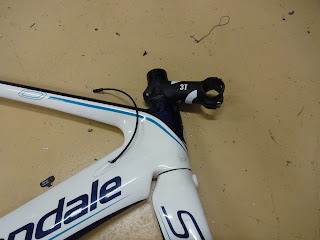 |
| DOWNTUBE CABLE ENTRY |
INSTALL INTERNAL
CABLES
Once the frame is prepared the internal cables can be
installed. I used old shifter cables to
feed through as trace wires and then attached the trace wire to the SD50 Di2
Cables with tape and draw them through.
A
few tips for drawing the cables through:
- Masking tape holds better than electrical tape
- Tape the trace wire in line with the plug so it fits through the 5.5mm holes
- Only wrap tape once around the 5mm plug, any more will get stuck in the 5.5mm holes
- Wrap plenty of tape on the trace wire to get a good grip on it
- Plug cables it into the B junction straight away while you work on the others
- Make sure you have the proper Di2 plug tool
Get all the cables through and connected at the B Junction
I fit up the derailleurs and A junction and plug them in then push any excess cable length back into the
frame and slide the B Junction inside the bottom bracket cavity.
I allow some length for the rear derailleur cable to move
across all 10 gears and check that the fork can turn through full range without
pulling on the cables.
Finally use the Shimano SM-EWC2 cable tape to secure the
cables to the frame around the front derailleur and stem. This keeps them out of the way and reduces
the risk of damage.
INSTALL INTERNAL BATTERY
The Battery needs to go in the seat tube and there are a few options. Most Di2 specific bikes have a grommet and
clip retainer available to secure the battery in the seat tube. I couldn’t find such a thing so I am going to
use a flexible Polyurethane adhesive to bond the battery in place.
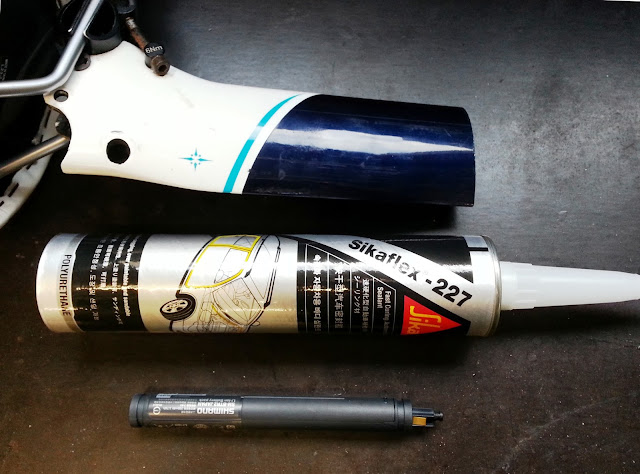 |
| READY TO BOND BATTERY INSIDE SEAT POST |
I spread the adhesive on both sides of the battery, inserted it against the front side of the seat tube with slight pressure to spread the Sika. I then used a pop stick and hacksaw blade to smooth out the back side and form a fillet join between the battery and either side of the seat tube.
 |
| ADD TWO BEADS OF ADHESIVE TO THE BATTERY |
 |
| INSERT BATTERY AND SMOOTH OUT ADHESIVE |
I used is Sikaflex 227 which I is used by coachbuilders for fibreglass panels. It is flexible, dampens vibration, won’t harm the epoxy resin. It can be sliced with a utility knife and prised or scraped loose to remove the battery.
The result is very secure. I installed my SHIV TT battery two years ago
and have ridden 10,000km with no hassles.
Subscribe to:
Posts (Atom)
